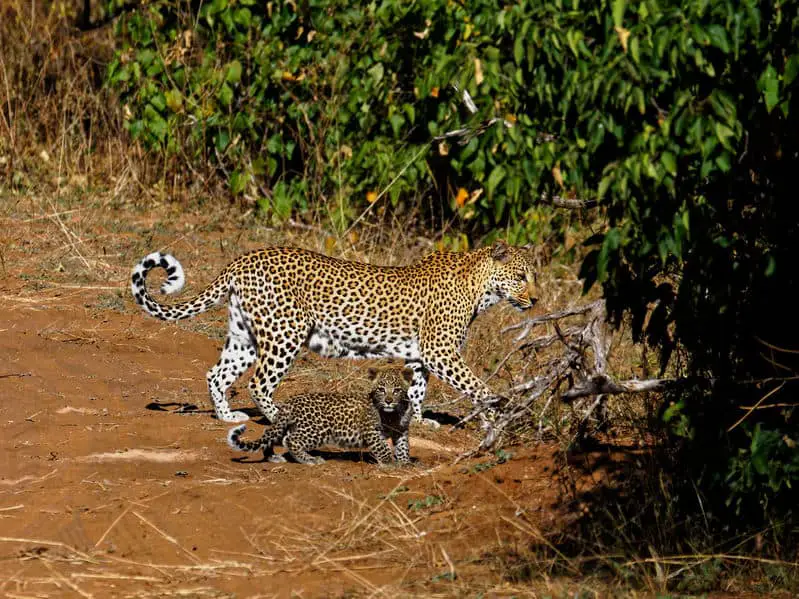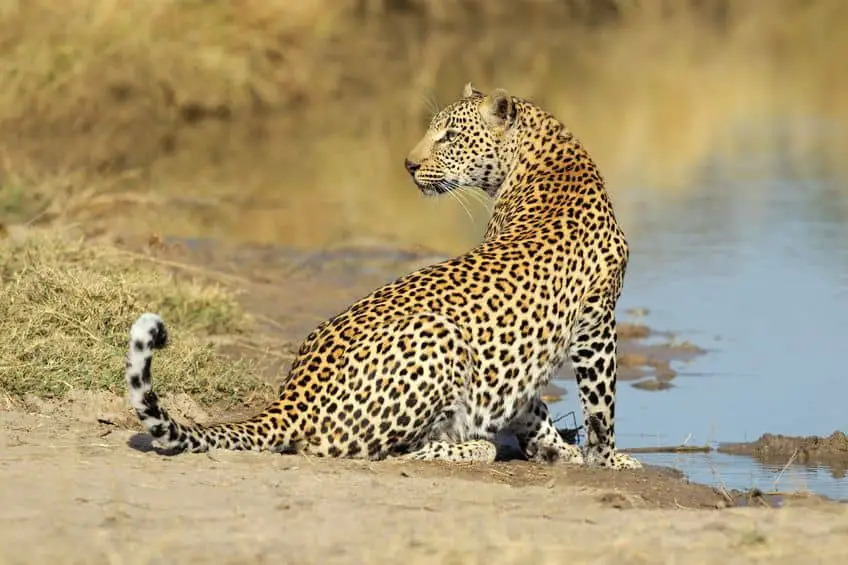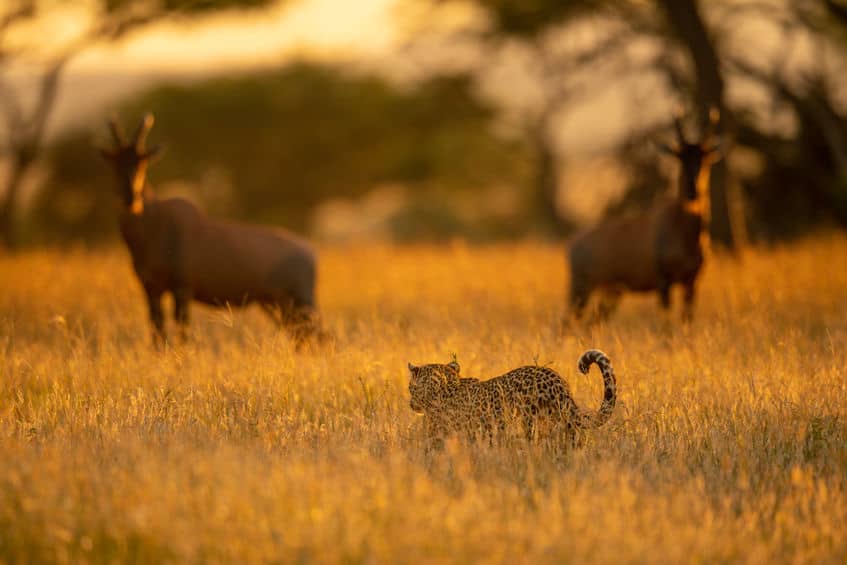
Leopards are often referred to as Africa’s most efficient hunters and there are many good reasons for that as we will discover in this post. Leopards are extremely skilled hunters and not only are they built for stealth and camouflage but they are also incredibly strong animals.
This post is packed with interesting information and fascinating facts about African leopards and will surely answer any question you may have about them.
But first, here is a quick summary of the facts this post covers so you can go ahead and find the ones you find most interesting.
These are the 18 most important and fascinating facts about leopards:
- Leopards are strong and bulky cats that can weigh up to 200 pounds (91 kg).
- Leopards are the smallest of the big five.
- Leopards have a lifespan of 17 years in nature and 23 years in captivity.
- Leopards are solitary creatures.
- Leopards are territorial animals.
- A group of leopards is called a leap.
- Female leopards raise cubs alone.
- Leopards are built for stealth and strength.
- Leopards are some of Africa’s best hunters.
- Leopards can eat over 100 different animals.
- Leopards are excellent climbers.
- Leopards are nocturnal.
- Leopards can be seen in most of sub-Saharan Africa.
- Leopards only have few natural enemies.
- Leopards can thrive in many types of habitats.
- Leopards can sometimes be born as black panthers.
- Leopards belong to the Felidae family.
- The conservation status of leopards is ‘vulnerable’ and there are roughly 700,000 leopards left in the wild in Africa.
Scientific Facts About Leopards
Before we get into each of the facts listed above, here is a table with some raw, scientific facts about African leopards.
| Scientific name | Panthera pardus |
| Family | Felidae |
| Lifespan | In nature: 17 years In captivity: 23 years |
| Solitary or social | Solitary |
| Group name | Leap |
| Group size | 1 |
| Weight | Male: 44 to 200 lb (20 to 91 kg) Female: 37 to 128 lb (17 to 58 kg) |
| Height | 2 to 2.3 ft (60 to 70 cm) |
| Length (head and body) | 3.3 to 4.9 ft (1 to 1.5 m) |
| Length (tail) | 2 to 3.6 ft (60 to 110 cm) |
| Top speed | 37 mph (60 km/h) |
| Primary food | Medium-sized antelopes |
| Where in Africa | Sub-Saharan Africa |
| Habitat | Savanna, forest, shrubland, desert, grassland, and mountains |
| Natural enemies | Lions |
| Conservation status | Vulnerable |
| Population in Africa | 700,000 |
| Gestation period | 90 to 110 days |
| Weight at birth | 1 to 1.3 lb (450 to 600 gr) |
| Height at birth | 3 to 4 in (7.5 to 10 cm) |
| Number of offspring | 1 to 4 |
Now let us dive deeper into all of the fascinating facts and information about leopards.
Leopard Appearance And Anatomy

Leopards are big cats that can be found in most of Africa and large parts of Asia. They are easily recognizable and distinguishable from other big African cats since they have certain features in their appearance and anatomy that make them unique.
Leopards weigh between 55 and 66 pounds (25 to 30 kg) on average, with the males being slightly larger than the females. They measure 2 to 2.3 ft (60 to 70 cm) in height and 3.3 to 4.9 ft (1 to 1.5 m) in length. The tail adds an extra 2 to 3.6 ft (60 to 110 cm) to that.
The weight of leopards can vary greatly from region to region and male leopards have been measured to weigh between 44 and 200 pounds (20-91 kg) and female leopards between 37 and 128 pounds (17-58 kg)
Leopards will typically be smaller in areas where there are only small prey animals and larger in areas where large prey animals are found in bountiful numbers.
Leopards’ fur is colored in different nuances of yellow ranging from almost orange on their backs to almost white on their belly and one of the most characteristic and well-known features of leopards is the dark, circular, or rosette-shaped markings all over their fur.
These markings can also be seen on the tail and the head, although they are significantly smaller and often just looks like black dots, especially on the head.
Leopards are dense, bulky, muscular, and front-heavy animals. Their head is large and has a classical cat-like shape. Their neck and jaw are muscular and extremely strong and their eyes have a yellow and sometimes almost green color.
Leopards are built for strength and that is very visible when looking at their legs which are both thick and strong and their paws which are large and wide. Leopards’ front paws are larger than their back paws which is an important feature since it allows them to climb more easily while carrying heavy prey in their mouth.
A reason why leopards have such large and strong legs and paws is that they rely heavily on their ability to climb well which we will dive deeper into later in this post.
Like most other cats, leopards have retractable claws which are excellent for climbing, fighting, and killing prey. When leopards relax, their claws are retracted.
They also have a long, slightly curved tail which provides them with excellent balance when chasing prey or climbing trees.
Leopards Are The Smallest Of The Big Five
Leopards are members of the so-called big five. A group that got its name from being widely perceived as being the five most dangerous African animals to hunt on foot. Today, the name is more often associated with safari tourism than hunting.
The big five consist of Cape buffalos, elephants, leopards, lions, and black rhinoceroses. If you are interested in learning more about the big five, take a look at this post which is packed with interesting facts about the legendary group of African wildlife.
Leopards are the smallest member of the big five but that is in no way a disadvantage for them as they rely heavily on stealth and camouflage and being able to sneak up on unsuspecting prey.
Despite their somewhat small size, leopards are also incredibly strong animals. A combination that makes them very efficient hunters.
Leopard Lifespan

Leopards in the wild have a lifespan of 17 years although they rarely actually get to live for that long due to rough living conditions such as natural enemies, diseases, or other unforeseen circumstances.
On average, leopards in Africa live for 10 to 12 years depending on the region.
Like many other animals, leopards in captivity have a longer lifespan than they do in the wild if they are given good living conditions and taken good care of.
Leopards in captivity have a lifespan of 23 years.
The reason why leopards (and many other animals for that matter) have a longer lifespan in captivity than they do in the wild is that threats such as natural enemies are no longer an issue and diseases are less common and most often cured if they occur.
Leopards Are Solitary Creatures
Unlike lions, the other big cat that is also a member of the big five, leopards are solitary creatures which means that they live on their own for most of their lives.
As a result of efficient and effective evolution, leopards have developed themselves and their skills and abilities in ways that allow them to thrive on their own. They are, for instance, experts in solo hunting and surviving.
Leopards Are Territorial Animals
Leopards are very territorial animals and each leopard has its own territory that it defends from other leopards of the same sex.
Despite being very territorial animals, there are actually no fixed borders between their territories, and two leopards of the same sex can have overlapping territories.
In Kenya, leopards have been observed having territories that overlapped by as much as 70%.
In cases where two neighboring leopards have overlapping territories, they seem to accept the fact that they have a close neighbor but will generally not use the shared part of their territory when the other leopard is there.
Like with most other species of wild cats, male leopards have significantly larger territories than females and a single male territory can contain as many as 6 different female territories.
A Group Of Leopards Is Called A Leap
Although fully grown leopards are solitary creatures, grown female leopards have cubs for most of their life.
A group of leopards consisting of a mother and her cubs are referred to as a leap of leopards.
In this beautiful footage, you can see a leap of leopards consisting of a mother and her cubs that are on the move.
Leopards And Their Offspring
Female leopards reach sexual maturity between the age of 2 and 4 years. When they reach sexual maturity, female leopards will seek out a couple of suitable mates to have offspring of their own.
After mating, male leopards will leave the females and will not participate in raising the cubs. Female leopards will raise their cubs on their own.
Female leopards will usually mate with multiple males (usually 2 to 3) as a way of ensuring extra protection for their cubs. The reason for this is that male leopards often seek out and kill cubs, and despite not participating much in raising their own cubs, they will leave them alone and let them live.
The reason why male leopards systematically seek out and kill cubs seems to be to prevent or reduce competition in the future.
So by mating with a couple of different males, they will not know who the actual father of the cubs is and therefore, all the males that a female has mated with will leave the cubs alone.
Female leopards have a gestation period of 90 to 110 days after which they give birth to a litter of cubs. They will usually have between 1 and 4 but can sometimes have up to 6 cubs.
The newborn cubs are so small that they can fit within the palm of a hand. They weigh between 1 to 1.3 pounds (450 to 600 grams) and measure just 3 to 4 inches (7.5 to 10 cm).
At birth, the newborn cubs have grey, almost silver-colored fur but will quickly start developing their well-known yellow coat with the characteristic dark, circular or rosette-shaped markings over the first few months of their lives.
Like many other animals, leopards are born with closed eyes. They open their eyes after about a week (ranging from around 4 to 9 days)
Leopard mothers will keep their cubs hidden for the first 6 weeks of their lives to keep them safe from predators such as hostile male leopards as mentioned above but also lions, hyenas, and African wild dogs can be a threat. During this time, they will move to a new location every few days to reduce the risk of being tracked down by enemies.
While this is a good strategy for reducing the risk of being killed by larger predators, the small cubs are still at risk of being killed by snakes that are large enough to eat them.
For the first 3 months of their lives, leopard cubs’ diet consists exclusively of milk from their mother but around the age of 3 months, they will slowly begin to eat various scraps of meat that their mother brings back from hunting and meat will slowly become a larger and larger portion of their diet until they eat meat exclusively like their mother.
Around the age of 3 months, leopard cubs will also begin to follow their mother when she goes hunting so they can observe how she does it and try to imitate her to practice the important skill for themselves.
Around the age of 2 years, the young leopards will leave their mother to go out and live solitary lives like all other grown leopards.
Leopards Are Built For Stealth And Strength
Leopards have often been referred to as Africa’s most efficient hunters. They are extremely elusive animals and part of what makes them such efficient hunters is their ability to utilize stealth and camouflage when hunting.
Leopards are experts in stealth and sneaking up on unsuspecting enemies. They are truly built for it.
Like other cats, leopards have a large arsenal of super-sensitive cat senses that help them be extremely aware of their own bodies and their surroundings.
Leopards have whiskers, not only on their face but also all over their legs. These whiskers are connected to some extremely sensitive nerves that will let the leopards know as soon as something comes in contact with them.
On top of that, leopards have some extra sensitive hairs all over their fur that lets them know exactly how close they are to the surrounding vegetation, soil, rocks, etc.
The combination of their super-sensitive cat senses, their whiskers, and extra sensitive hairs all over their fur gives leopards total and complete awareness of their entire bodies and allows them to sneak around completely unnoticed without making any noises that might startle potential prey animals.
On top of being true experts at stealth, leopards are also incredibly strong animals. Unlike the similarly-looking cheetah which is built for speed, leopards are dense and bulky cats with strong legs, paws, and jaws. They are built for strength.
Despite being built for stealth, camouflage and, strength, leopards are actually also quite fast and can reach speeds of 37 mph (60 km/h). Compared to cheetahs, however, that is not much as cheetahs can reach speeds almost twice that of leopards. It is also not as fast as some of their regular prey animals.
Leopards and cheetahs might seem very similar and in many ways, they are, with both of them being big African cats that hunt many of the same animals but there are actually many significant differences between the two cats.
If you are interested in learning more about the differences between leopards and cheetahs, you can take a look at this post in which I have covered 20 of the most significant differences between them in both their appearance and behavior.
Leopards Are Some Of Africa’s Best Hunters

As we have already determined, leopards are extremely strong animals that are also experts in stealth and camouflage and they utilize these skills especially when they hunt.
Since they are not quite as fast as much of their prey, leopards rely on the element of surprise when they hunt.
Leopards will sneak up on their unsuspecting target and get as close as they can, often within 15 feet (about 5 meters), before they leap forward for the kill.
Leopards Can Eat Over 100 Different Animals
Leopards are not at all picky when it comes to the animals they hunt and eat. In fact, they can hunt and eat more than 100 different species of animals.
What they hunt depends largely on what animals live in their territory and varies greatly from region to region.
Leopards seem to prefer to hunt and eat medium-sized antelopes such as impalas and springboks but in areas where these are not found in bountiful numbers, they can hunt almost anything ranging from small beetles, frogs, and scorpions and all the way up to young giraffes and zebras. In some areas, leopards will even go after fish and birds.
Leopards Are Excellent Climbers
Another skill that makes leopards unique and that they have truly mastered is climbing. This skill often comes in handy for a variety of different reasons.
For instance, leopards will often carry their kills high up into a tree to secure it from predators such as lions, hyenas, and African wild dogs who are not as skilled climbers as leopards are. In fact, hyenas and wild dogs cannot climb trees at all.
Leopards are so strong and agile that they can carry prey that is much larger and heavier than themselves up into trees using their powerful jaws and strong legs and paws while they navigate through the branches.
Sometimes, lions, hyenas, and wild dogs can chase leopards and since they usually stay in groups, they have a big advantage over leopards who are solitary creatures. They rarely (but occasionally) intend to kill the leopards that they chase but rather to steal their food for an easy meal.
When being chased by predators, leopards will often utilize their incredible climbing skills to quickly escape up into a tree, making it impossible for the attacker to catch it.
Another slightly less dramatic reason why leopards often climb trees is simply that they like to rest or sleep while laying on a large branch as this provides them with both security from predators and also shade from the crown.
African leopards are often spotted in trees and if you are curious about why this is, I encourage you to take a look at this post which goes much more in-depth with that topic.
A good trick to increase your chances of spotting a leopard on your safari is to look for their long, slightly curved tail hanging down from large branches.
Leopards Are Nocturnal

Like most other wild cats, leopards are nocturnal creatures and there are several interesting reasons why that is.
Leopards are nocturnal because they have several qualities that give them advantages when hunting at night. The qualities include excellent night-vision and several super-sensitive senses that allow the leopards to hunt very efficiently at night.
One of the primary reasons why leopards are nocturnal is that it is simply easier for them to hunt prey during the darkness of the night as most of their usual prey animals are diurnal, meaning that they are active during the day and rest or sleep at night.
Leopards also have incredibly strong night vision which gives them a huge advantage over their prey when hunting at night. Their night vision is 7 times stronger than that of a human.
Another advantage leopards gain from hunting at night is the reduced competition from cheetahs who, interestingly enough and unlike other cats, are diurnal.
So to increase your chances of spotting a leopard, I recommend going on game drives in the very early morning or the late evening, ideally before sunrise or after sunset.
This post goes into much more depth about why leopards are nocturnal.
Leopards Can Be Seen In Most Of Sub-Saharan Africa
Leopards can be seen in most of sub-Saharan Africa. They are native to more than 35 African countries but since they are highly elusive animals, you have to be either lucky or very skilled (or ideally both) to see them.
I have written this post that gives you 3 of my best tips for spotting leopards.
Some of the best places in Africa to spot leopards include:
- Kruger National Park, South Africa
- Etosha National Park, Namibia
- Masai Mara National Reserve, Kenya
- Serengeti National Park, Tanzania
- Moremi Game Reserve & Okavango Delta, Botswana
Leopards Only Have Few Natural enemies
Due to their impressive strength and sharp and deadly claws and teeth, leopards do not have many natural enemies.
They can, however, meet competition and even be killed by lions, hyenas, and African wild dogs who often stay in larger groups and therefore outnumber and are easily able to take down solitary leopards.
Most of the time when lions, hyenas, and wild dogs chase or attack leopards, it is to steal their food and since they easily outnumber a leopard, the leopard will be forced to give up its food unless it can escape and drag the food up into a tree in time.
Leopards Can Thrive In Many Types Of Habitat
Leopards can be found all over sub-Saharan Africa. They are very adaptable animals and can thrive in many types of habitat as long as they have animals to hunt and as we have already learned, leopards are not at all picky with what they hunt and eat.
Leopards are often seen in savannas, forests, shrublands, and grasslands but can also be seen in deserts and mountains.
Leopards Can Sometimes Be Born As Black panthers

On very rare occasions, leopards can be born with black fur. Black leopards are often referred to as black panthers or just panthers.
Black panthers are not a distinct species but rather a genetic variation that can occur in several types of wild cats including leopards. Black leopards can be born in litters where either of the parents is black.
The black color of the skin and fur in panthers is caused by the production of a dark pigment called melanin in the animals’ skin and fur through a process called melanism. Melanism is the opposite of albinism, which causes people or animals to become very pale or white due to the lack of the pigment melanin.
Black panthers can occur in 13 of the 37 different wild cat species and are most common in leopards in Africa and Asia, and jaguars in Central- and South America.
Almost all leopards are born with grey, almost silver-colored fur that changes to the well-known yellow coat with dark, circular markings over the first few weeks and months but on very rare occasions, if either the mother or the father of the cubs was a black panther, one or some of the cubs can also become black panthers.
A litter of leopard cubs can consist of both black panthers and regular-colored leopards as the production of melanin can vary greatly from one cub to another.
Being a black panther does not seem to be a disadvantage for leopards when it comes to hunting or hiding. In fact, it could be argued that it could potentially give them a minor advantage as the black color of the fur might make hiding and sneaking up on prey a bit easier.
Black panthers are extremely rare in the wild. They are mostly seen in Asia but even there, they are only seen on very rare occasions.
The last time a confirmed sighting of a black panther in the wild happened in Africa was in 2019 in Kenya. Before that, the last confirmed sighting of a black panther in Africa happened 110 years earlier. (source).
Sightings of black panthers in Africa have, however, been reported many times over the last many decades although none of them have been officially confirmed.
Reportings of black panther sightings are most common in Kenya and Ethiopia and since the last confirmed sighting also happened in Kenya, it is not unlikely that at least some of the non-confirmed sightings are legitimate.
Black panthers live in the same regions and habitats as other leopards. Mostly savannas, forests, shrublands, and grasslands but also deserts and mountains.
If you are curious about black panthers and want to learn more about them, take a look at this post which is packed with fascinating information about black panthers.
Leopards Belong To The Felidae Family
Leopards belong to the Felidae family of animals which is the well-known family of mammals, most commonly referred to as cats.
Other members of the Felidae family are tigers, jaguars, pumas, lynxes, and domestic cats.
In Africa some of the members of the Felidae family are, leopards, lions, cheetahs, servals, and caracals.
Population And Conservation Status Of Leopards
The global population of leopards is declining. A big reason for this is a reduction in the numbers of prey animals, which is largely caused by a loss of habitat, which is mostly a result of man-made projects such as agriculture.
According to Encyclopedia Britannica, there are roughly 700,000 leopards left in Africa and according to IUCN, the conservation status of leopards is vulnerable.
